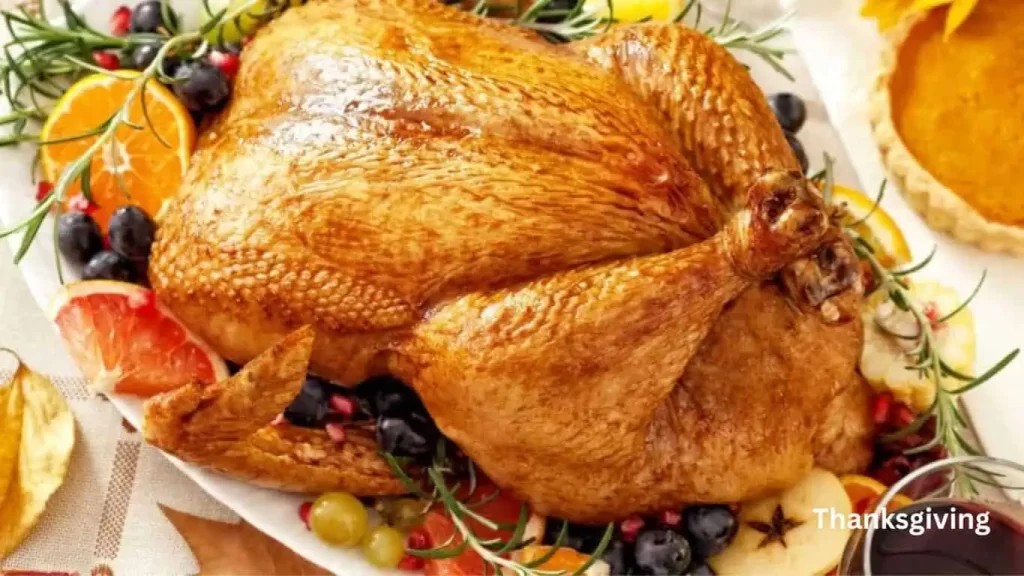How to Host a Great Gluten-Free Thanksgiving Dinner
This post may contain affiliate links. I may receive a small commission if you purchase something through these links, which helps me continue to deliver great content. I never recommend products I wouldn’t use myself!
Thanksgiving is a time for gathering, gratitude, and of course, good food. But for those with celiac disease or gluten sensitivity, this holiday can be fraught with anxiety. How do you create a traditional feast without the gluten? DON’T WORRY!!!
Hosting a gluten-free Thanksgiving dinner doesn’t mean sacrificing flavor or tradition. In this post, I’ll guide you through planning, preparing, and serving a delicious gluten-free Thanksgiving that everyone at your table will love.
1. Planning Your Gluten-Free Thanksgiving Dinner Menu
Start by planning your menu with classic Thanksgiving dishes but with a gluten-free twist. Focus on dishes like turkey, sweet potatoes, cranberry sauce, green bean casserole, and pumpkin pie that can be easily adapted to a gluten-free version.
Tips:
- Use gluten-free flour as a substitute in baking and gravy recipes.
- Opt for naturally gluten-free foods like brussels sprouts, wild rice, and fresh turkey.
- Most whole turkeys are naturally gluten-free. However, be cautious with pre-seasoned or brined turkeys, as these may contain gluten. Stick to a plain bird and season it yourself.
- For the gravy replace wheat flour with cornstarch or a gluten-free flour blend for thickening.
- Stuffing: Use gluten-free bread cubes or try a wild rice stuffing instead.
- Green Bean Casserole: Swap the traditional cream of mushroom soup for a homemade gluten-free version, and use gluten-free fried onions on top.
- Mashed Potatoes are naturally gluten-free, just be sure any additions (like chicken broth) are also gluten-free.
If you’re considering adding alcoholic beverages to your gluten-free Thanksgiving dinner, it’s important to ensure they meet gluten-free standards. Check out the linked post for a comprehensive guide for more details on which beverages are safe.
Remember, always read labels carefully. Gluten can hide in unexpected places like bouillon cubes, seasonings, and even some brands of butter. When in doubt, opt for whole, unprocessed ingredients.
Gluten-Free Recipe Suggestions
Here are some delicious gluten-free alternatives to try for your Gluten-Free Thanksgiving Dinner:
- Gluten-Free Herb Stuffing: Use gluten-free bread cubes, herbs, and vegetables for a traditional taste without the gluten.
- Gluten-Free Dinner Rolls: Try a blend of gluten-free flours for soft, fluffy rolls that rival their wheat counterparts.
- Crustless Pumpkin Pie: Skip the crust altogether for a rich, creamy dessert that’s naturally gluten-free.
- Gluten-Free Apple Crisp: Use gluten-free oats and a gluten-free flour blend for the topping.
While focusing on gluten-free options, don’t forget to consider other dietary restrictions your guests might have. Some guests may need dairy-free or nut-free options as well. When inviting guests, ask about any dietary restrictions in advance so you can plan accordingly.

2. Choosing Your Ingredients for Your Gluten-Free Thanksgiving Dinner
Having the right ingredients on hand will make your gluten-free cooking much easier. Here are some essential gluten-free staples to stock up on:
- Gluten-Free Flour Blend: Look for an all-purpose gluten-free flour blend that can be substituted 1:1 for regular flour in most recipes. Brands like Bob’s Red Mill, King Arthur, and Cup4Cup are widely available.
- Gluten-Free Breadcrumbs: They are great for stuffing, casserole toppings, or breading. You can buy these pre-made or make your own from gluten-free bread.
- Gluten-Free Broth or Bouillon: Many regular broths contain gluten, so be sure to get a gluten-free version.
- Xanthan Gum: This helps improve the texture of gluten-free baked goods.
- Gluten-Free Oats: Regular oats often have cross-contamination, so look for certified gluten-free oats.
- Gluten-Free Soy Sauce or Tamari: Regular soy sauce contains wheat, but gluten-free versions are readily available.
- Cornstarch: This is great for thickening gravies and sauces.
Where to Buy Gluten-Free Products:
- Local Grocery Stores: Many mainstream supermarkets now have dedicated gluten-free sections. Stores like Whole Foods, Sprouts, and Trader Joe’s often have extensive gluten-free options.
- Health Food Stores: These typically carry a wide range of gluten-free products.
- Online Retailers: Websites like Amazon, Thrive Market, and Vitacost offer a vast selection of gluten-free products, often at competitive prices.
- Direct from Manufacturers: Many gluten-free brands sell directly through their websites, sometimes offering bulk discounts.
- Local Gluten-Free Bakeries: Support small businesses and get fresh gluten-free baked goods for your Thanksgiving feast. Find a local bakery using the interactive travel map.
By properly preparing your kitchen and stocking up on the right ingredients, you’re setting yourself up for gluten-free Thanksgiving success. Remember, the extra effort you’re putting in will ensure that all your guests can safely enjoy the meal and focus on what really matters – gratitude and togetherness.
When shopping for your Thanksgiving meal, always check labels to ensure products are gluten-free. Many grocery stores offer gluten-free versions of traditional Thanksgiving ingredients. Don’t forget to pick up gluten-free gravy packets, and gluten-free cornbread mix for stuffing.
Key Ingredients:
- Gluten-free pie crust for your pumpkin pie and apple pie.
- Gluten-free soy sauce or alternatives like tamari for seasoning.
- Gluten-free dinner rolls to complete your meal.
3. Preparing the Kitchen before starting your cooking
Now that we’ve planned our gluten-free Thanksgiving menu, it’s time to get our kitchen ready. This step is crucial for ensuring a safe and delicious meal for all your guests, especially those with celiac disease or gluten sensitivity.
Avoiding Cross-Contamination
For those with celiac disease, even a tiny amount of gluten can cause serious health issues. That’s why avoiding cross-contamination is absolutely essential. Here’s how to create a safe cooking environment:
- Deep Clean Your Kitchen: Before you start any food preparation, give your kitchen a thorough cleaning. Pay special attention to countertops, cutting boards, and any nooks where flour might have settled. Don’t forget to clean your oven and microwave too!
- Use Separate Utensils: If you’re preparing both gluten-free and gluten-containing foods, use separate utensils. This includes mixing spoons, cutting boards, and even pot holders. Consider color-coding your tools to easily distinguish between gluten-free and regular items.
- Create Designated Prep Areas: If possible, set up a separate area for gluten-free food preparation. This could be as simple as using a different counter space or setting up a temporary workspace on a clean table.
- Be Mindful of Shared Appliances: Toasters, stand mixers, and food processors can harbor gluten particles. If you’ve used these for gluten-containing foods in the past, it’s best to use new or thoroughly cleaned appliances for your gluten-free cooking.
- Watch Out for Sponges and Dishcloths: These can easily transfer gluten particles. Use fresh, clean cloths for your gluten-free prep and cooking.
Remember, it only takes a crumb to cause a reaction in someone with celiac disease. When in doubt, take extra precautions!
4. Hosting Tips for your Gluten-Free Thanksgiving dinner
Now that your kitchen is prepared and your menu is planned, let’s focus on creating a warm, inclusive atmosphere for all your guests. Hosting a gluten-free Thanksgiving doesn’t just involve the food – it’s also about communication and thoughtful presentation.
Communication with Guests
Open and clear communication is key to a successful gluten-free gathering. Here’s how to approach it:
- Inform Guests in Advance: When you send out invitations or confirm attendance, mention that you’re hosting a gluten-free Thanksgiving. This gives guests time to prepare and ask questions.
- Explain the Reason: If you’re new to hosting gluten-free gatherings, briefly explain why you’re doing so. Whether it’s for your own health or to accommodate a family member, understanding often leads to support.
- Address Potluck Contributions: If guests offer to bring dishes, politely request that they bring gluten-free options. You could say something like, “We’re having a gluten-free Thanksgiving this year. If you’d like to bring a dish, we’d love if it could be gluten-free. I’m happy to suggest some ideas if you need them!”
- Handling Non-Gluten-Free Contributions: If a guest insists on bringing a gluten-containing dish, ask them to bring it in a sealed container and label it clearly. You can set up a separate area for these items to avoid confusion.
Creating a Gluten-Free Atmosphere
A gluten-free Thanksgiving should feel just as warm and inviting as any other. Here are some tips to ensure everyone feels included:
- Set a Welcoming Table: Use place cards, festive decorations, and a beautiful centerpiece to create a warm atmosphere. The focus should be on togetherness, not dietary restrictions.
- Label Dishes Clearly: Use small place cards or labels to identify each dish and note that it’s gluten-free. This not only helps those avoiding gluten but also sparks conversations about the delicious gluten-free options.
- Share the Menu: Consider printing out menus for each place setting. This adds a touch of elegance and allows guests to see the full range of gluten-free options available.
- Be Prepared to Educate: Some guests might be curious about gluten-free eating. Be ready to answer questions positively, focusing on the delicious food rather than restrictions.
- Have Some Fun: Consider adding a “guess which dish is traditionally gluten-free” game to spark conversation and show how many beloved dishes are naturally gluten-free.
Serving Tips
Careful serving is the final step in ensuring a safe, gluten-free meal. Here are some important points to remember:
- Use Separate Serving Utensils: Provide a clean, separate serving spoon or fork for each dish to prevent cross-contamination.
- Create a Gluten-Free Buffet Zone: If you’re serving buffet-style, group all the gluten-free dishes together. This minimizes the risk of cross-contamination and makes it easier for gluten-free guests to navigate the options.
- Serve Gluten-Free Guests First: If you have guests with celiac disease, consider letting them serve themselves first to absolutely ensure no cross-contamination has occurred.
- Keep Gluten-Containing Items Separate: If you do have any gluten-containing dishes, place them at the end of the buffet line and make sure they have their own serving utensils.
- Use Visual Cues: Consider using different colored plates or serving dishes for gluten-free and gluten-containing items as an extra precaution.
Remember, the goal is to create an inclusive, enjoyable experience for everyone. By communicating clearly, creating a welcoming atmosphere, and serving thoughtfully, you’ll host a Thanksgiving where everyone feels cared for and included. After all, that’s what this holiday is all about!
5. Final Tips for a Stress-Free Thanksgiving
Hosting Thanksgiving dinner can be stressful, and adding gluten-free considerations might seem overwhelming. But with proper planning and organization, you can enjoy a relaxed and joyful celebration. Here are some final tips to ensure a smooth, stress-free Thanksgiving:
Preparation Timeline
Starting your preparations early is key to avoiding last-minute panic. Here’s a suggested timeline:
1-2 Weeks Before:
- Finalize your menu and guest list
- Order your turkey if you haven’t already
- Shop for non-perishable items and gluten-free staples
- Make and freeze pie crusts, dinner rolls, or other baked goods
3-4 Days Before:
- Shop for fresh ingredients
- Thaw your turkey in the refrigerator (allow 24 hours for every 4-5 pounds)
- Make cranberry sauce
- Prepare any soups or casseroles that can be reheated on Thanksgiving
2 Days Before:
- Chop vegetables for stuffing and side dishes
- Prepare any salad dressings or marinades
- Make pies or other desserts
1 Day Before:
- Set the table
- Prepare stuffing and refrigerate
- Make mashed potatoes and store them in the refrigerator
- Assemble any casseroles so they’re ready to bake
Thanksgiving Day:
- Cook the turkey
- Bake stuffing and casseroles
- Reheat pre-made dishes
- Make gravy
- Warm dinner rolls
Remember, many gluten-free baked goods taste best when fresh, so items like rolls might be best baked on Thanksgiving day.
Staying Organized
Here are some tips to keep you calm and organized on Thanksgiving day:
- Create a Detailed Checklist: Write down everything you need to do, from cooking tasks to setting up the dining area. Check items off as you go.
- Enlist Help: Don’t try to do everything yourself. Assign tasks to family members or willing guests.
- Set the Table the Night Before: This saves time and stress on Thanksgiving day.
- Use Post-It Notes: Label serving dishes with the name of the dish they’ll hold. This makes setting up the buffet or table much easier.
- Clean as You Go: Keep the sink filled with soapy water to wash items as you use them, preventing a pile-up of dirty dishes.
- Have a Plan for Leftovers: Prepare containers in advance for guests to take home leftovers.
- Take Breaks: Remember to pause, breathe, and enjoy the process. Thanksgiving is about gratitude, not perfection!
Hosting a gluten-free Thanksgiving might seem daunting at first, but it’s entirely achievable with the right planning and mindset. By carefully selecting your recipes, preparing your kitchen, communicating with your guests, and staying organized, you can create a delicious and safe meal that everyone can enjoy.
Remember, Thanksgiving is about coming together and expressing gratitude. Your efforts to accommodate dietary needs are a beautiful expression of care for your guests. Embrace the challenge as an opportunity to explore new recipes and create new traditions.
We hope this guide helps you host a wonderful gluten-free Thanksgiving. The joy on your guests’ faces when they realize they can safely enjoy everything on the table will make all your efforts worthwhile.
Now we’d love to hear from you! Have you hosted a gluten-free Thanksgiving Dinner before? Do you have any favorite gluten-free holiday recipes or tips to share? Please leave a comment below with your experiences or any questions you might have. Your insights could be incredibly helpful to others in our community.
And if you found this guide helpful, don’t forget to share it with friends or family who might be planning their own gluten-free holiday meals. Together, we can make the holiday season enjoyable and inclusive for everyone, regardless of dietary restrictions.
Happy Thanksgiving, and happy gluten-free hosting!










